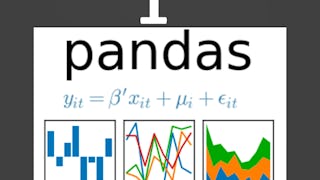This Pandas course focuses on mastering DataFrame functionalities, starting with in-depth comparisons between Series and DataFrame methods.

Läuft in 3 Tagen aus. Bringen Sie Ihre Karriere in Schwung mit 40 % Rabatt auf Kurse von Adobe, IBM und anderen Anbietern. Jetzt sparen.


Intermediate Data Analysis Techniques with Pandas
Dieser Kurs ist Teil von Spezialisierung Data Analysis with Pandas and Python
Unterrichtet in Deutsch (KI-Synchronisation)

Dozent: Packt - Course Instructors
Bei  enthalten
enthalten
Empfohlene Erfahrung
Empfohlene Erfahrung
Was Sie lernen werden
Utilize advanced data selection and column operations techniques in Pandas.
Employ various filtering techniques to enhance data extraction precision.
Apply Pandas methods proficiently to clean and prepare data effectively.
Manage and manipulate MultiIndex and text data within Pandas for comprehensive data handling.
Kompetenzen, die Sie erwerben
- Kategorie: Data Wrangling
- Kategorie: Data Cleansing
- Kategorie: Text Mining
- Kategorie: Data Manipulation
- Kategorie: Data Integration
- Kategorie: Data Analysis Software
- Kategorie: Pandas (Python Package)
- Kategorie: Data Transformation
Wichtige Details

Zu Ihrem LinkedIn-Profil hinzufügen
8 Aufgaben
Erfahren Sie, wie Mitarbeiter führender Unternehmen gefragte Kompetenzen erwerben.

Erweitern Sie Ihre Fachkenntnisse
- Lernen Sie neue Konzepte von Branchenexperten
- Gewinnen Sie ein Grundverständnis bestimmter Themen oder Tools
- Erwerben Sie berufsrelevante Kompetenzen durch praktische Projekte
- Erwerben Sie ein Berufszertifikat zur Vorlage

In diesem Kurs gibt es 7 Module
In this module, we will explore the foundational concepts of working with DataFrames in Pandas, starting with a comparison of Series and DataFrame methods and attributes. You will learn to select and manipulate both single and multiple columns, and add new columns to your DataFrames. We will cover the use of value_counts for column analysis and strategies for handling missing values. Additionally, you'll master data type conversions using the astype method, sorting DataFrames with sort_values and sort_index, and ranking values within columns using the rank method.
Das ist alles enthalten
14 Videos2 Lektüren1 Aufgabe
In this module, we will dive into filtering data within DataFrames. You'll be introduced to the dataset and learn memory optimization techniques. We will cover filtering rows based on conditions and using logical operators like AND (&) and OR (|). Advanced filtering methods such as isin, isnull, and notnull will be explored. You'll also learn to filter data within a range using the between method, identify and handle duplicates with duplicated and drop_duplicates, and find and count unique values using unique and nunique methods.
Das ist alles enthalten
10 Videos1 Aufgabe
In this module, we will explore essential data extraction techniques in Pandas. You'll start with an introduction to the dataset and learn to set and reset indices using set_index and reset_index methods. We will cover retrieving rows by index positions with iloc and by labels with loc, and understand the second arguments for precise data retrieval. You'll learn to overwrite individual and multiple values, rename index labels or columns, and delete rows or columns. Advanced extraction techniques like sampling with the sample method, extracting specific rows with nsmallest and nlargest, conditional filtering with where, and executing functions across DataFrame rows or columns with apply, will also be covered.
Das ist alles enthalten
13 Videos1 Aufgabe
In this module, we will focus on working with text data in Pandas. You'll start with an introduction to the dataset and learn to use common string methods for text data manipulation. We will cover filtering DataFrame rows using string methods and applying these methods to DataFrame indices and columns. You'll master the split method to divide text data into multiple parts and enhance your skills with additional practice exercises. Finally, you'll learn to customize text splitting using the expand and n parameters of the split method for more detailed analysis.
Das ist alles enthalten
7 Videos1 Aufgabe
In this module, we will explore the advanced capabilities of MultiIndex in Pandas, starting with an introduction to its concepts. You'll learn to create and manage MultiIndex DataFrames for complex data grouping and analysis. We will cover techniques to extract and rename index level values for clarity, and how to sort and extract specific rows for better data organization. Additionally, you'll master methods like transpose, stack, and unstack to reshape DataFrames, and apply pivot, melt, and pivot_table methods to reorganize and transform data efficiently.
Das ist alles enthalten
12 Videos1 Aufgabe
In this module, we will delve into the GroupBy functionality in Pandas, starting with an introduction to its essential concepts for data aggregation. You'll learn to use the groupby method to group data and retrieve specific groups with the get_group method. We will explore various aggregation methods available on GroupBy objects and cover techniques for grouping data by multiple columns. Additionally, you'll master the agg method to apply multiple operations on grouped data and learn to iterate through groups for individual data processing.
Das ist alles enthalten
7 Videos1 Aufgabe
In this module, we will explore essential techniques for merging DataFrames in Pandas. You'll begin with an introduction to various merging methods, followed by a detailed look at using the pd.concat function to concatenate DataFrames along a specified axis. We will cover left joins and the use of left_on and right_on parameters for specific column matching, as well as inner joins to combine DataFrames based on intersecting keys. Additionally, you'll learn about full-outer joins to merge DataFrames including all keys from both frames, and how to merge by indexes using left_index and right_index parameters. Finally, you'll be introduced to the join method as a simpler alternative for merging DataFrames.
Das ist alles enthalten
10 Videos1 Lektüre2 Aufgaben
Erwerben Sie ein Karrierezertifikat.
Fügen Sie dieses Zeugnis Ihrem LinkedIn-Profil, Lebenslauf oder CV hinzu. Teilen Sie sie in Social Media und in Ihrer Leistungsbeurteilung.
Dozent

von
Mehr von Data Analysis entdecken
 Status: Kostenloser Testzeitraum
Status: Kostenloser Testzeitraum Status: Kostenloser Testzeitraum
Status: Kostenloser Testzeitraum Status: Kostenloser Testzeitraum
Status: Kostenloser Testzeitraum
Duke University


Coursera Project Network
Warum entscheiden sich Menschen für Coursera für ihre Karriere?





Neue Karrieremöglichkeiten mit Coursera Plus
Unbegrenzter Zugang zu 10,000+ Weltklasse-Kursen, praktischen Projekten und berufsqualifizierenden Zertifikatsprogrammen - alles in Ihrem Abonnement enthalten
Bringen Sie Ihre Karriere mit einem Online-Abschluss voran.
Erwerben Sie einen Abschluss von erstklassigen Universitäten – 100 % online
Schließen Sie sich mehr als 3.400 Unternehmen in aller Welt an, die sich für Coursera for Business entschieden haben.
Schulen Sie Ihre Mitarbeiter*innen, um sich in der digitalen Wirtschaft zu behaupten.
Häufig gestellte Fragen
Yes, you can preview the first video and view the syllabus before you enroll. You must purchase the course to access content not included in the preview.
If you decide to enroll in the course before the session start date, you will have access to all of the lecture videos and readings for the course. You’ll be able to submit assignments once the session starts.
Once you enroll and your session begins, you will have access to all videos and other resources, including reading items and the course discussion forum. You’ll be able to view and submit practice assessments, and complete required graded assignments to earn a grade and a Course Certificate.
Weitere Fragen
Finanzielle Unterstützung verfügbar,


